Letters from Iwo Jima Blu-ray Movie
HomeLetters from Iwo Jima Blu-ray Movie 
Warner Bros. | 2006 | 141 min | Rated R | May 22, 2007
Movie rating
8 | / 10 |
Blu-ray rating
| Users | 4.3 | |
| Reviewer | 4.0 | |
| Overall | 4.2 |
Overview
Letters from Iwo Jima (2006)
The story of the battle of Iwo Jima between the U.S. and Japan during World War II, as told from the perspective of the Japanese who fought it.
Starring: Ken Watanabe, Kazunari Ninomiya, Tsuyoshi Ihara, Ryō Kase, Shidō NakamuraDirector: Clint Eastwood
| Drama | Uncertain |
| War | Uncertain |
| History | Uncertain |
| Epic | Uncertain |
| Foreign | Uncertain |
Specifications
Video
Video codec: VC-1
Video resolution: 1080p
Aspect ratio: 2.40:1
Original aspect ratio: 2.39:1
Audio
Japanese: Dolby TrueHD 5.1
Japanese: Dolby Digital 5.1
Subtitles
English, English SDH, French, Spanish
Discs
50GB Blu-ray Disc
Single disc (1 BD)
Playback
Region free
Review
Rating summary
| Movie | 4.0 | |
| Video | 4.5 | |
| Audio | 4.0 | |
| Extras | 4.0 | |
| Overall | 4.0 |
Letters from Iwo Jima Blu-ray Movie Review
Taking a black page from history, Eastwood delivers a stark, unflinching and humanist portrait of Japanese soldiers.
Reviewed by Greg Maltz September 22, 2007Clint Eastwood's Japanese perspective of the battle of Iwo Jima is like a cloud. In shifting shades of foreboding and despondence, the film delivers an account of events with the action of a war epic, the detail of a documentary and the emotional impact of a drama. Collectively, the experience of the Japanese troops takes on many forms. Some characters, including the leader, Lt. General Tadamichi Kuribayashi (Ken Watanabe), are too complex to pin down firmly. Others, like the bumbling Saigo (Kazunari Ninomiya), are motivated only to return to their family and care nothing for the war or their superiors. From idealistic honor to bitter defeat to heartbroken fatalism, the spirit of the soldiers is given life decades after the war from the words they wrote on Iwo Jima. Using the troops' handwritten letters as a vehicle for his film, Eastwood attempts to focus his lens on the humanity of a battle that was inhuman.
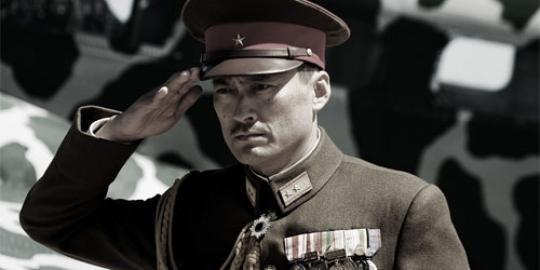
General Kuribayashi (Ken Watanabe), whose charter was to defend Iwo Jima against American forces, finds himself facing a superior military.
Hopelessly outnumbered and outgunned, the Japanese forces on Iwo Jima were concerned less with how to win than with how to die. Once mainland Japan leadership established that no reinforcements, tanks or planes could be spared in the defense of Iwo Jima, Kuribayashi and his men knew that the battle was essentially a suicide mission. Eastwood shows in brutal detail that the Japanese code of honor led many troops to pull their grenade pins and hold the explosive charges against their chests with grisly results. Other soldiers engaged in banzai missions at the command of their leaders. While those offensive tactics were largely effective against the poorly trained Chinese forces Japan faced earlier in the war, the US military made short work of the charging Japanese soldiers. Still, Letters from Iwo Jimo shows how the Japanese dug in to the island's rugged terrain to inflict maximum damage to the Americans.
At many points, the film dovetails with Flags of Our Fathers, Eastwood's sister production that portrays the war from the U.S. soldiers' perspective. In fact, both films were shot at the same time to make use of closely linked scenes. But where Flags of Our Fathers was mostly unsuccessful in establishing a strong emotional bond between the audience and the soldiers, Saigo was the key to the power of Letters from Iwo Jima. Through Saigo, the audience experienced not only the overall horror endured by Japanese forces, but also the moments of humanity. Saigo was the one character guided purely by human instincts and not by Japan's reckless chain of command. What the movie doesn't show is that Japan badly terrorized the people of China, the Philippines and other Asia/Pacific countries in the most inhuman ways imaginable. Iwo Jima was America's stepping stone--a key strategic base to eventually put a stop to Japan's war machine. And that is why the battle of Iwo Jima, in spite of its barren locale, was a critical front in the war and a worthy focal point in history.
Letters from Iwo Jima Blu-ray Movie, Video Quality 
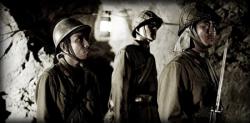
Warner's BD-50 features a VC-1 codec and an aspect ratio of 2.4:1. Eastwood
opted for a more subdued look for the film, toning down vibrant colors for a
homogenous feel common to several recent war movies that make use of
computer-generated images, including Flags of Our Fathers. Very few scenes
in either movie included digital images--the landing of U.S. forces on the
island being one notable exception. That scene is dramatic in demonstrating
the scale of the assault, with dozens of battleships offshore and amphibious
assault vehicles coming onshore. The resolution was not only impressive but
absolutely essential in showing the invasion in this brief scene. It harkens
back to the much longer, famous scene in Saving Private Ryan, when U.S.
forces stormed Omaha Beach. Indeed, the film treatment was similar and not
surprisingly Steven Spielberg coproduced the film with Eastwood. NTSC could
simply not resolve the individual U.S. soldierss invading the beach of Iwo
Jima from the camera's vantage point.
Contrast and black level are excellent, and the detail adds to the stark
realism of the production. Much of the action takes place at night and in
dimly lit caves dug into the volcanic rock of Iwo Jima. I noticed no
pixelation or artifacts in black areas of the screen and overall the picture
was remarkably "undigital", as if coming from a projector. During one
of the
most haunting scenes in the film, as Saigo defies the general's orders and
buries the letters rather than burns them, watch the detail and crisp
accuracy of the picture as it ranges from shadow to light--even smoke is
resolved with stunning clarity. The resolution lends itself to microdetail
and Eastwood's characters and landscapes deliver an endless supply of
interesting visual cues. However, if you are looking for reference-quality
vibrance, depth and realism, Letters from Iwo Jima falls short.
Letters from Iwo Jima Blu-ray Movie, Audio Quality 
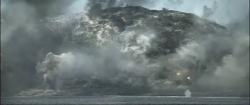
With no LPCM track, the film falls short of audio reference quality as well. The Dolby TrueHD Japanese 5.1 delivers convincing, detailed vocals, explosions, small arms sounds and plane engine roar, but lacks that open, ultrarealistic soundstage audiophiles crave. With no English track, the subtitles become especially important, but it is instructive to hear the officers' commands and dialog in Japanese, and the chants of "banzai, banzai, banzai". The audio engineering makes excellent use of surrounds and LFE content.
Letters from Iwo Jima Blu-ray Movie, Special Features and Extras 
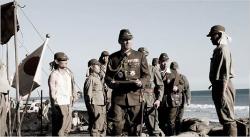
The special features included on the BD-50 are very impressive. Red Sun Black Sand is a making-of documentary that, like all the supplementary content, also appears on the DVD version. Here it is upgraded to high definition and proves a worthy companion to the film, with important interviews and behind-the-scenes footage. Next is a featurette on the cast, entitled "The Faces of Combat". Rounding out the content is a collection of photographs, the November 2006 world premiere coverage at Budo-kan in Tokyo and the corresponding press conference, as well as a theatrical trailer.
Letters from Iwo Jima Blu-ray Movie, Overall Score and Recommendation 
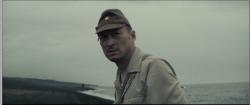
The emotional power of Letters from Iwo Jima lies in its underlying message that Japanese
soldiers and American soldiers were cut from the same cloth. When the Japanese forces take a
wounded American prisoner, a letter from his mother is found in his pocket. General Kuribayashi
translates the letter into Japanese as he reads it aloud to his men. In a moment of disarming
honesty, one of the Japanese soldiers who previously demonized the Americans confides in Saigo
that this letter is exactly what any of their mothers would write. The general even uses the
words of the concerned American mother in guiding his troops near the end.
When the letters of the Japanese troops are finally discovered and dug up by analysts studying
the battle site, we hear a flood of voices earnestly reading the words. The sound of all the
messages merging is overwhelming and Eastwood wants us to realize that each of the men who
died defending Iwo Jima for Japan had a story and a family back home, just like the U.S. soldiers.
The danger of this type of emotional message is the same danger Hollywood runs into whenever
it shows the human side of inhuman battles and forces. Japan committed war crimes so horrific,
China and the Philippines have yet to fully recover. It was in the shadow of this violence that
America made the difficult decision to force Japan to surrender by using atomic bombs.
Similar titles
Similar titles you might also like

Flags of Our Fathers
2-Disc Special Edition
2006

My Way
마이웨이 / Mai Wei
2011

The Bridge on the River Kwai
1957

Land of Mine
Under Sandet
2015

Patton
1970

City of Life and Death
南京!南京! / Nanjing! Nanjing!
2009

The Longest Day
1962

Das Boot
The Director's Cut | Single-Disc Edition
1981

Downfall
Der Untergang | Collector's Edition
2004

Generation War
Unsere Mütter, unsere Väter
2013

Overlord
1975

A Bridge Too Far
1977

Kagemusha
影武者
1980

Stalingrad
1993

Full Metal Jacket 4K
Rerelease
1987

Winter in Wartime
Oorlogswinter
2008

The Captain
Der Hauptmann
2017

Breaker Morant
1980

Fat Man and Little Boy
1989

Zulu
1964